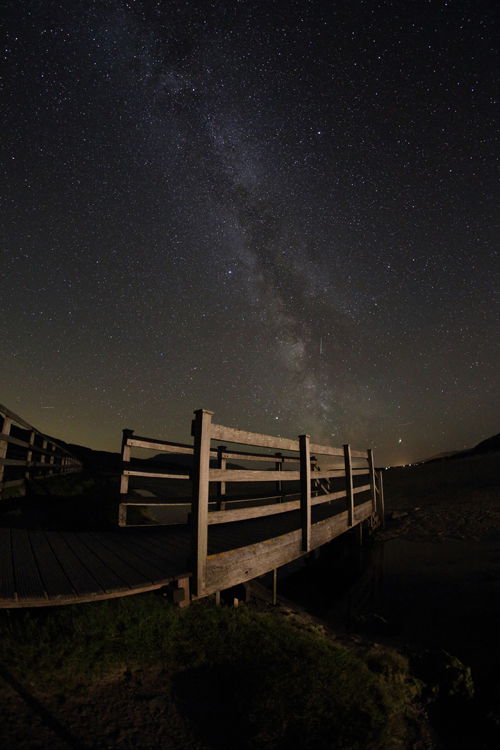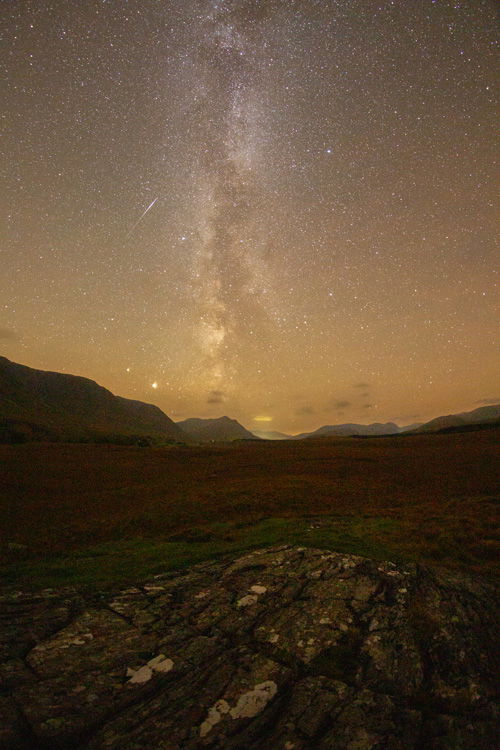Why the West of Ireland is fantastic for Astrophotography. 🌌
"Another glorious dawn awaits—not a sunrise, but a galaxy-rise; a morning filled with 400 billion suns, the Milky Way rising."
Carl Sagan
One of the most magnificent sights in all of nature is the night sky peppered with stars, distant planets and streaking meteors. Luckily for those of us who live in the West of Ireland, County Mayo has one of the best celestial dark skies in the Country.
Ireland is home to two internationally recognised dark sky places Kerry International Dark Sky Park and Mayo International Dark Sky Park. (located at Ballycroy National Park). Both have been awarded a gold tier for the quality of their night skies, free from light pollution and are both important assets of natural night sky heritage.

Light pollution map showing Ballycroy National Park as being one of the very best places for Astrophography in Ireland.
The Bortle Scale.
The Bortle scale is the way of measuring the quality (brightness) of the night sky for a particular location. There are nine levels to the Bortle scale with Class 9 being the most extreme amount of light pollution. Along with Ballycroy National Park, the West and North coasts of Mayo are typical examples of Bortle class 2. If you are photographing the night sky looking towards the ocean from these areas you are shooting into a Bortle class 1 which will give you some outstanding results in the images you take.
The categories are,
Class 1: Excellent dark-sky site.
Class 2:Typical Truly dark site.
Class 3: Rural sky.
Class 4: Rural/urban transition
Class 5: Suburban sky.
Class 6: Bright suburban sky.
Class 7: Suburban/urban transition.
Class 8: City sky.
Class 9: Inner City sky.

Ursa Major Constellation is clearly seen over Dun Briste, North Mayo.
Best time to shoot.
So, when’s the best time to go and photograph the night sky in County Mayo? The Milky Way and other constellations can be photographed all year, but the Milky Way's galactic core appears only now, in the middle of February. It is the inclusion of the core in the photograph that makes the shot stand out. The "Milky Way Season" runs from now, the 11th of February, until about mid-September or early October, and depending on the weather, particularly cloud cover, this phenomenon can be photographed in all its glory any night.

The Milky Way Over Beltra lough, Glenisland.

WW2 Look Out Post Downpatrick Head.
Equipment.
To begin astrophotographing the stars, all you need is an ordinary DSLR camera with a remote shutter release, a sturdy tripod, and a wide (fast) lens, F2.8 or better. Most of my shots are made up of just one image with a small bit of post-processing done in Photoshop to get the most out of the genuine color that exists in the Milky Way but that the naked eye cannot see. A little understanding of photography basics, namely aperture, shutter speed, and ISO settings, will also be helpful. A small tip is to start at F2.8 for 20 seconds at ISO 3200 or 6400 and adjust from there if needed when you see the results.

Entrance Bridge to Silverstrand,, Killadoon.
Foreground Interest.
To make the image really stand out, include some sort of foreground interest. The foreground can be lit by using light painting with a torch or low-level lighting. Long exposures using artificial light or just natural ambient light like moonlight can have a great effect on your astrophotography.
And I nearly forgot to mention that, for you to get the most out of astrophotography, it means getting out of bed at unearthly hours of the night. then going out into the night and finding yourself standing in the frost and cold for hours on end to get that one elusive shot.
But is it worth it? Yes, for sure. When you see the final image,

Silverstrand, Killadoon.

Silverstrand, Killadoon.

The Plough over Birreencorragh and Nephin Mountain.

Lough Carra, Moorehall.

Napoleonic Tower, Achill Island.

Carrickmore and Carrickmore South viewed from Mweelaun, Achill Island.

Milky Way looking towards the “Mothers Devil” in the Erriff Valley.

The Milky Way over Croagh Patrick pictured from Bertra Beach.

Ballycroy National Park at night

Mweelrea Mountain from Silverstrand